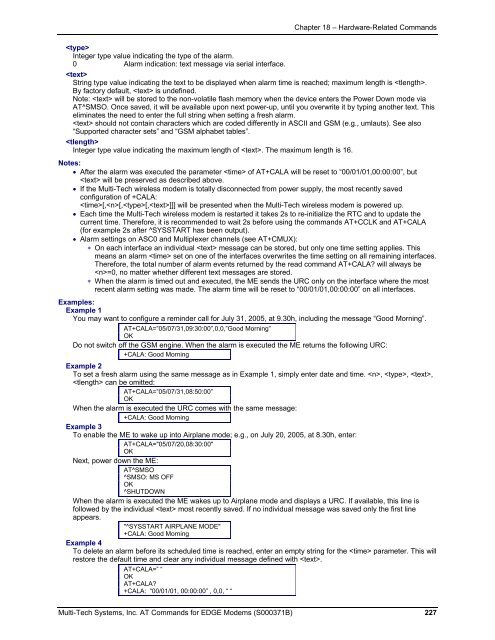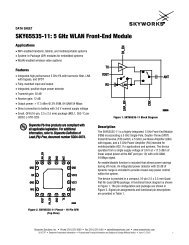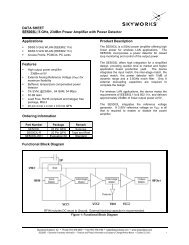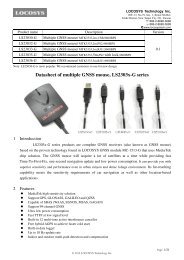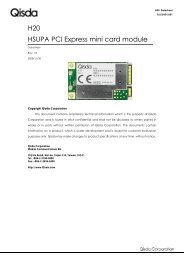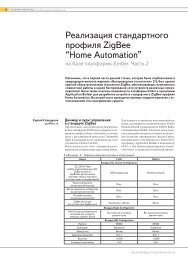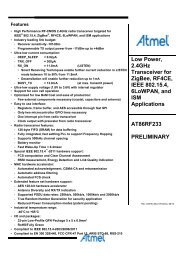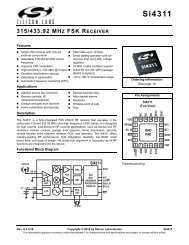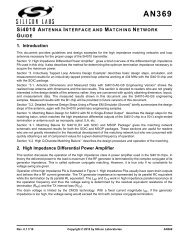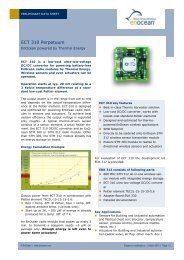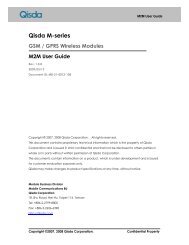AT Command Reference Guide for EDGE Wireless ... - wless.ru
AT Command Reference Guide for EDGE Wireless ... - wless.ru
AT Command Reference Guide for EDGE Wireless ... - wless.ru
Create successful ePaper yourself
Turn your PDF publications into a flip-book with our unique Google optimized e-Paper software.
Chapter 18 – Hardware-Related <strong>Command</strong>s<br />
<br />
Integer type value indicating the type of the alarm.<br />
0 Alarm indication: text message via serial interface.<br />
<br />
String type value indicating the text to be displayed when alarm time is reached; maximum length is .<br />
By factory default, is undefined.<br />
Note: will be stored to the non-volatile flash memory when the device enters the Power Down mode via<br />
<strong>AT</strong>^SMSO. Once saved, it will be available upon next power-up, until you overwrite it by typing another text. This<br />
eliminates the need to enter the full string when setting a fresh alarm.<br />
should not contain characters which are coded differently in ASCII and GSM (e.g., umlauts). See also<br />
“Supported character sets” and “GSM alphabet tables”.<br />
<br />
Integer type value indicating the maximum length of . The maximum length is 16.<br />
Notes:<br />
• After the alarm was executed the parameter of <strong>AT</strong>+CALA will be reset to “00/01/01,00:00:00”, but<br />
will be preserved as described above.<br />
• If the Multi-Tech wireless modem is totally disconnected from power supply, the most recently saved<br />
configuration of +CALA:<br />
[,[,[,]]] will be presented when the Multi-Tech wireless modem is powered up.<br />
• Each time the Multi-Tech wireless modem is restarted it takes 2s to re-initialize the RTC and to update the<br />
current time. There<strong>for</strong>e, it is recommended to wait 2s be<strong>for</strong>e using the commands <strong>AT</strong>+CCLK and <strong>AT</strong>+CALA<br />
(<strong>for</strong> example 2s after ^SYSSTART has been output).<br />
• Alarm settings on ASC0 and Multiplexer channels (see <strong>AT</strong>+CMUX):<br />
∗ On each interface an individual message can be stored, but only one time setting applies. This<br />
means an alarm set on one of the interfaces overwrites the time setting on all remaining interfaces.<br />
There<strong>for</strong>e, the total number of alarm events returned by the read command <strong>AT</strong>+CALA will always be<br />
=0, no matter whether different text messages are stored.<br />
∗ When the alarm is timed out and executed, the ME sends the URC only on the interface where the most<br />
recent alarm setting was made. The alarm time will be reset to “00/01/01,00:00:00” on all interfaces.<br />
Examples:<br />
Example 1<br />
You may want to configure a reminder call <strong>for</strong> July 31, 2005, at 9.30h, including the message “Good Morning”.<br />
<strong>AT</strong>+CALA=”05/07/31,09:30:00”,0,0,”Good Morning”<br />
OK<br />
Do not switch off the GSM engine. When the alarm is executed the ME returns the following URC:<br />
+CALA: Good Morning<br />
Example 2<br />
To set a fresh alarm using the same message as in Example 1, simply enter date and time. , , ,<br />
can be omitted:<br />
<strong>AT</strong>+CALA=”05/07/31,08:50:00”<br />
OK<br />
When the alarm is executed the URC comes with the same message:<br />
+CALA: Good Morning<br />
Example 3<br />
To enable the ME to wake up into Airplane mode; e.g., on July 20, 2005, at 8.30h, enter:<br />
<strong>AT</strong>+CALA="05/07/20,08:30:00"<br />
OK<br />
Next, power down the ME:<br />
<strong>AT</strong>^SMSO<br />
^SMSO: MS OFF<br />
OK<br />
^SHUTDOWN<br />
When the alarm is executed the ME wakes up to Airplane mode and displays a URC. If available, this line is<br />
followed by the individual most recently saved. If no individual message was saved only the first line<br />
appears.<br />
"^SYSSTART AIRPLANE MODE"<br />
+CALA: Good Morning<br />
Example 4<br />
To delete an alarm be<strong>for</strong>e its scheduled time is reached, enter an empty string <strong>for</strong> the parameter. This will<br />
restore the default time and clear any individual message defined with .<br />
<strong>AT</strong>+CALA=” “<br />
OK<br />
<strong>AT</strong>+CALA<br />
+CALA: “00/01/01, 00:00:00” , 0,0, “ “<br />
Multi-Tech Systems, Inc. <strong>AT</strong> <strong>Command</strong>s <strong>for</strong> <strong>EDGE</strong> Modems (S000371B) 227


